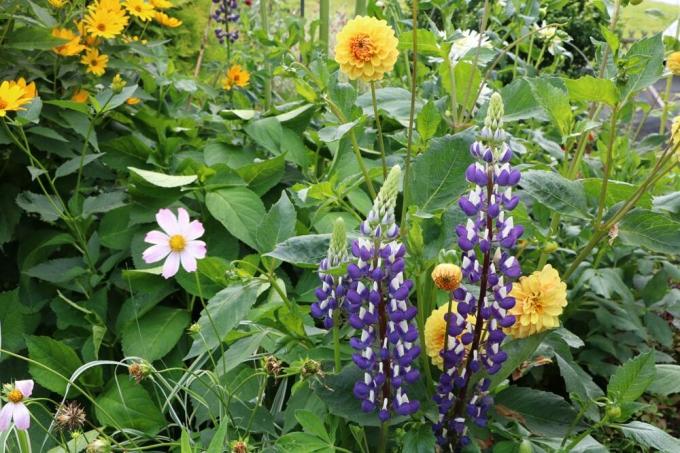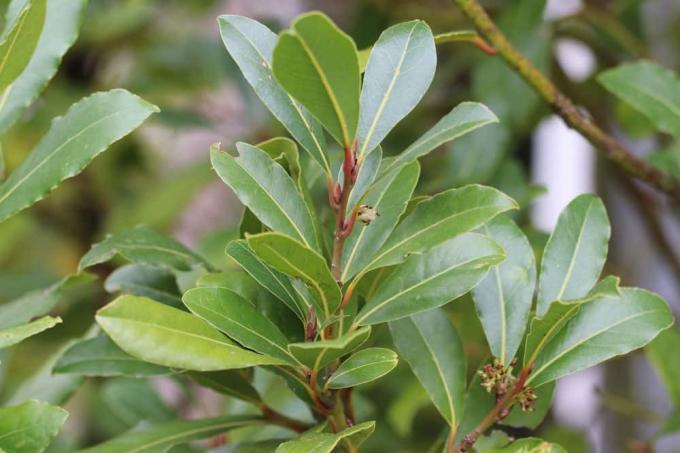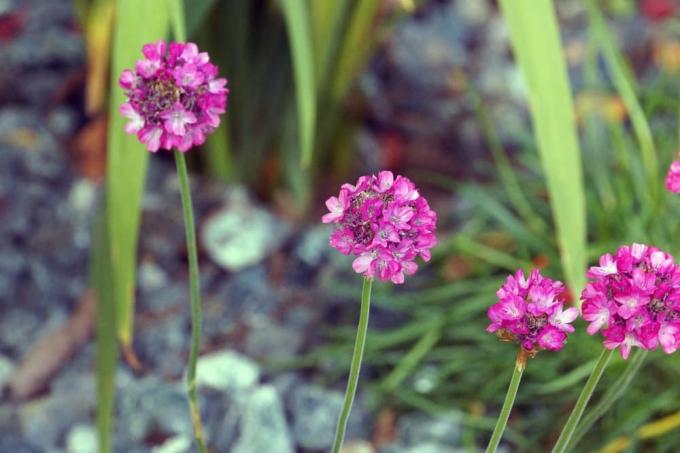

Table of contents
- sowing
- Cultivation behind glass
- Sow in a peat pot
- direct sowing
- Care
- Beautiful plant neighbors
- Special feature – sweet lupine
- Taste of sweet lupins
- Sowing the sweet lupins in the garden - yellow and blue lupins
- Care of the sweet lupine
- harvesting the seeds
- Conclusion
Yellow and blue lupins are considered indispensable classics in the garden. It is no coincidence that the large community of hobby gardeners is full of praise for the talented papillae. The bandwidth of their advantageous attributes extends from unique ornamental value to ecological value. Their majestic flowering candles set impressive accents, attract hordes of bees and butterflies and enrich the soil with nitrogen. The following instructions explain how you can plant these botanical sparklers in your green kingdom by sowing them and how to take care of them.
sowing
If you are already cultivating wolf beans, these and their legumes will provide numerous seeds for sowing in autumn. Whether yellow and blue lupins develop in the garden is like a gardening roulette. Since these are usually hybrids, even the expert cannot predict which hereditary traits of the parent and grandparent plants will prevail in the individual seeds. If you want to be on the safe side, you can buy the seed from a specialist shop, because here a selection took place in advance at the producer. In contrast to the colorful mixtures, you will of course have to dig a little deeper into your pocket. For the sowing itself, you have the choice between cultivation behind glass and direct sowing. Both methods are explained in more detail below.
Cultivation behind glass
Yellow and blue lupins can be sown all year round in the greenhouse or on the windowsill. The best time is early to mid-April. How to do it right:
- Soak the seeds in water or chamomile tea for 12-24 hours
- Fill small pots with lean substrate, such as peat sand, coconut hum, seed or herbal soil
- Put one seed at a time 1-2 cm deep in the ground
- Moisten with water from the spray bottle
- Place in an indoor greenhouse or spend a bright, warm spot
Germination begins within a week, with the first tender leaves emerging from the seeds. Keep the substrate constantly moist without causing waterlogging. After about 4 weeks the seeds will have turned into vigorous young plants that can be transplanted outdoors.
Tip:
To ensure that the seed soil is not infected with fungal spores, viruses or pests, it is disinfected before use. Place the substrate in a fireproof container in the oven at 150 degrees for 30 minutes or in the microwave for 10 minutes at 800 watts.
Sow in a peat pot

A comfortable variant for sowing in plastic pots are peat pots. This is high-quality growing substrate that has been filled into a net and compressed. Laid out in a watertight shell with a transparent hood, the tabs swell with the addition of water. The seeds are simply put in, the lid is put on and the complete bowl is placed in a bright, warm place. Once germination has started, the hood has done its duty and the seedlings will continue to thrive. For watering, the water is poured into the mini greenhouse to gently water the young plants from below. After a month, the yellow and blue lupins are ready to be planted outdoors. At this point, another advantageous aspect of this method comes to light, because the wolf beans are placed in the ground together with the source pot, without any stressful untamping.
Tip:
The toxicity of the lupine seeds should be considered in all planting and care work. Wearing gloves should be a matter of course. Resist the attempt to nibble on the juicy seeds unless you're absolutely certain you're holding a bitter-free sweet lupine.
direct sowing
Where indoor cultivation is not practical, direct sowing in the bed is a good idea. Choose a sunny, warm and sheltered spot that is characterized by humus-rich, loose soil. A low-lime pH value of around 6.5 is ideal. Too nutrient-rich soil causes unwanted yellowing of the foliage. With May and August two dates come into consideration. Here's how to do it:
- Rake the soil deeply
- Weed and carefully remove roots and stones
- Work in compost and horn shavings on the surface
- Level the bed with the rake
- Plant the soaked seeds 50 cm apart in the soil
- Sieve and moisten with soil, sand or vermiculite
A stretched insect net protects the seedbed from uninvited guests. If the natural amount of rain is not sufficient, it is watered as soon as the surface of the earth dries. Cheeky weeds are weeded every day if possible so that they do not overgrow the tender seedlings. Weak young plants are sorted out if necessary, if they do not want to develop to the desired extent despite a dose of diluted liquid fertilizer.
Tip:
Crop rotation should be taken into account when choosing a location. Only sow yellow and blue lupins in the garden where no legumes such as peas, lentils or other colored lupins have previously been planted.
Care
If sowing and planting went as planned, the care of yellow and blue lupins in the garden requires little effort. A regular water supply is only important in the year of planting, so that the deep-reaching taproots are well established. The normal care protocol of an established lupine includes the following points:
- Water in summer drought
- A start fertilization in March or April with compost and horn shavings is welcome
- A mulch layer of gravel or grit keeps the soil nice and warm
- Regularly cleaning out faded flowers always attracts new butterfly blossoms
With a bit of luck, cutting back the stems to 10 centimeters after flowering will encourage a second flower, which will be a little smaller. In the fall, lupins shed their above-ground parts to prepare for winter. Where the withered flowers and leaves are not a problem, they remain in the bed until next spring as additional winter protection. Shortly before new sprouting, the remains are cut off close to the ground.
Beautiful plant neighbors

In the right company, the magnificent appearance of yellow and blue lupins is particularly impressive. The following plant neighbors harmonize perfectly with a wolf bean:
- Columbine (Aquilegia spec.)
- Foxglove (Digitalis purpurea)
- Ringworm (Chrysogonum virginianum)
- Globe thistle (Echinops ritro 'Veitch's Blue')
- Marguerite (Leucanthemum vulgare)
- Irises (Iris spec.)
- Forget-me-not (Myosotis sylvatica)
- Purple Mullein (Verbascum phoeniceum)
- Sweet Sweet Clover (Melilotus albus)
The white-flowered meadow phlox (Phlox maculata 'Miss Lingard') and the silvery-blue catnip (Nepeta x faassenii 'Gletschereis') are explicitly to be emphasized as neighbors to the blue lupine. The yellow-brown riding grass (Calamagrostis x acutiflora 'Karl Foerster'), the white fine-rayed aster like to gather around the yellow lupine (Erigeron speciosus hybrid 'Summer fresh snow') and for the tone-in-tone design the yellow flowering sun bride (Helenium Hybride 'Waltraut').
Special feature – sweet lupine
Lupins in general are poisonous, but the related sweet lupine variety is not. The lupins are known as colorful flowering plants on the roadside.
However, only a few know that there are also varieties that could enrich our food industry. After all, their consumption is characterized by few calories and fat and it is also completely free of cholesterol and lactose. In principle, one can say that the sweet lupine is as versatile as soy, but completely without genetic engineering. If you take the seeds of the sweet lupine and process them into flour, you can use them to keep bread fresh or stabilize foam - and all this in a completely natural way. That would be a dream for agriculture and food production: the introduction of lupins without genetic modifications when used in food production. Extracts of the plant are already found in a few foods. Lupins could therefore supplement soy in the diet over the next few years or even replace it entirely. It can also be used in the animal feed industry without any problems.
Taste of sweet lupins
one might mistakenly assume that the taste is sweet, but this is not the case. It's more nutty - but very reserved, so that doesn't bother you, but can even underline the taste of other types of fruit in case of doubt. The sweet lupine does not contain the toxic bitter substances like its sister, the wild lupine, but it does contain minerals and fiber that are even said to prevent cancer. It is also extremely rich in protein. In addition, it contains a valuable cholesterol called HDL, which has a positive effect on cholesterol levels and can thus prevent a heart attack. Unfortunately, as is so often the case, there is also a downside to the coin: allergy sufferers could react sensitively to the consumption of lupine flour, similar to peanuts.
Sowing the sweet lupins in the garden - yellow and blue lupins
What about growing in your own garden? Incidentally, there is not yet too much experience in the cultivation of sweet lupins. If you want to grow them, you have to pay attention to the right soil conditions: it should be light and well-drained if possible. The PH value is ideally between 4 and 6.5. Above 7 is no longer suitable for cultivation. Seeds are used for this and if you have never grown lupins on the soil provided for this purpose, it is recommended to inoculate them beforehand with rhizobia strains specific to sweet lupins. You can order these together with the seeds – for example on the Internet.
The best time for sowing is in spring, in March or April. Seeds should be planted about 3 or 4 cm deep in the soil - about 60 seeds per square meter for white lupins and about twice that for blue lupins. The row spacing is 12 – 30 cm. There is no fertilization. There are different varieties on the market - blue lupins are Bordako, Bolivio and Boltensia, white lupins are Bardo or Amigo and yellow Borsefa Borsaja or Bormal. Blue lupins tolerate frosts down to -4°C and white ones to -8°C. So you can put them directly outside in spring.
Care of the sweet lupine
Lupins have a high water requirement both during germination and flowering. They have high heat requirements and have a growing season of 120-170 days, which again depends on the variety planted. The lupine can hardly hold its own against weeds - it is all the more important to tackle them in good time. In damp and warm weather, the dreaded lupine disease anthracnose or focal spot disease threatens. Those who use certified seeds can hope to prevent this disease.
harvesting the seeds
They can be harvested as seeds in August/September - preferably with a combine harvester. (Adjustment of the thresher similar to pea harvest). For storage, the crop should first be pre-dried.

Conclusion
Yellow and blue lupins enrich the garden with majestic flowering candles, serve as a pasture for bees and butterflies and enrich the soil with valuable nitrogen. In order for the legumes to achieve this masterpiece over many years, professional sowing is just as important as careful care. Since flexibility is one of the outstanding characteristics of lupins, you have the choice for sowing between cultivation behind glass throughout the year or sow the seeds directly into the bed in May or August. If the location is in a sunny, warm place with dry, lean and low-calcareous soil, care is limited to regular watering when it is dry.
 garden editorial
garden editorial I write about everything that interests me in my garden.
Learn more about garden plants - care

Lepidoptera, Faboideae - characteristics and representatives from A-Z
From the tropics to the arctic, legumes colonize our planet with more than 12,000 species. They serve us as ornamental and food plants or annoy us as weeds. Immerse yourself in the fascinating world of butterfly blossom plants. Get to know their characteristics and meet their representatives from A-Z.

Laurel tree has brown leaves - diseases + pests on laurel
If the spice laurel suddenly gets yellow leaves, which then turn brown and possibly fall off, the cause of the disease must be found out. This is the only way to do something against the dying of the laurel tree. In many cases, the plant can be saved quite easily.

Double garden jasmine, chanterelle tree - care, cutting and propagation
A concentrated, delicate white blossom and an enchanting scent characterize the double garden jasmine, which is also known under the name mock orange. It is therefore becoming increasingly popular in local gardens as hedges and privacy screens or as a solitaire. The ornamental tree is very easy to care for and should therefore not be missing in any garden.

Laurel tree, Laurus nobilis - information on care, propagation and wintering
The laurel tree is a popular, evergreen shrub that is suitable for pot culture or also grows in mild locations in the garden. Cared for and neatly cut, the dark green, leathery foliage can provide breathtaking accents in entrance areas or on terraces. You can find out how to properly care for the laurel here.

Thrift, Armeria - Varieties, care and information on winter hardiness/toxicity
Its long flowering period and uncomplicated care make the thrift a popular perennial that knows how to make a brilliant understatement. Where other summer flowers languish in the dry, sunny location, armeria trumps with colorful flowers. Explore the most beautiful varieties, practical care instructions and well-founded information on winter hardiness and toxicity.

Catchfly, Silene viscaria - sowing, planting & care
The pitcher (Lychnis viscaria) is a perennial, bushy wild perennial belonging to the Carophyllaceae family. Since it originally comes from the Mediterranean region, it is suitable for moor gardens, for green roofs, as a hardy garden perennial and as a decorative cut flower. The plant usually flowers from May to August in a strong fire or chimney red and reaches a height of about 40 to 50 cm.



